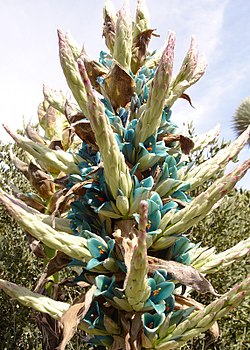Description
Puya alpestris grows as a xerophytic, perennial plant. A dense rosette of leaves is formed on a short stem. The tough, stiffly protruding, parallel-veined leaves run into a sharp point, have a length of over 1 meter and a width of 2 to 2.5 centimeters. The leaf margin is reinforced with hooked, curved, spines that are approximately 0.5 cm long. The underside of the leaf is dense white scales.
After many years, an upright, loose, paniculate overall inflorescence is formed, which is composed of numerous racemose partial branching inflorescences. The lower third of the branch contain stellate trichomes. It contains many bright red bracts and many individual flowers. The tips of the partial inflorescences are sterile. The flower stalk is about 7 mm long. The hermaphrodite flower is threefold. The three greenish sepals are about 2.3 cm long and hairy or bald. The three teal petals with blunt tips are about 4.5 cm long and spiral in as they fade. The six stamens have bright orange anthers. The flowers produce high amounts of nectar. During the flowering period, hummingbirds and other birds pollinate the flowers. The plant blooms between October and December in habitat. [1]
Capsule fruits are formed, in each of which many small, airworthy seeds are formed. After the seed development, the mother plant slowly dies. [2]
This page is based on this
Wikipedia article Text is available under the
CC BY-SA 4.0 license; additional terms may apply.
Images, videos and audio are available under their respective licenses.













